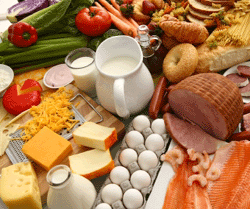 |
||||
Food Serving Sizes for Your Menopause DietIt's very easy to wildly overestimate food serving sizes This is partly because manufacturers often recommend unhealthily large portions on their packaging, and also because servings in restaurants, take-aways and fast food joints are so enormous.Keep an eye on how much you pile on to your plate, and use this list of food servings for common foods to guide you in your menopause diet. Fresh Fruit and vegetables
Fresh fruits and veggies are an important part of your menopause diet because they're rich in vitamins, minerals and phytochemicals (which simply means chemicals of plant origin), all of which help to prevent diseases and bolster your health. Try - try hard - to get a minimum of five servings of fresh fruit and veg a day and if you can manage more, don't hold back, particularly on the fresh vegetables. It sounds like a lot, but serving sizes are quite small. Juice at breakfast, chopped fruit on your cereal or sliced banana on your toast, salad in your lunchtime sandwich, a portion of fresh veg at supper time and an apple or pear as a snack during the day, and you're done. Visit our sister site, Healthy Eating Made Easy, for full details of fruit and vegetable servings. Protein foodsMenopause experts Christiane Northrup and Marilyn Glenville suggest that perimenopausal women include some high quality protein at every meal. You need protein during the change of life to keep your immune system in good shape, and help you lose fat and gain muscle when you use strength training exercises. Carrying more muscle on your body helps you to avoid weight gain in menopause simply because muscles burn more energy than fat. These food serving sizes are for a main meal - eat less if you are having a healthy snack: Eggs: 2 Fish: 100g (4oz) Meat (lean) or skinless poultry: 100g (4 oz) (a piece about the size of a pack of cards) Pulses, lentils or beans (cooked): 4 tbsp Nuts: 2 tbsp Soya/tofu/Quorn: 3 tbsp Dairy foodsMilk, cheese, cream and yogurt are great sources of protein and also calcium, an all-important bone-strengthening mineral for menopausal women. Dairy foods also high in fat, so include them in moderation, or use lower fat varieties of dairy food if you prefer, like skimmed (skim) or semi-skimmed (2% milkfat) milks, and low or zero fat yogurt or fromage frais. Cottage cheese: a small 200g (7 oz) tub Hard cheese: 40g (1.5 oz) (a chunk about the size of a small matchbox) Milk: 200ml (scant 1 cup) Yogurt (plain low fat ) or fromage frais: a small 150g (5 oz) pot CarbohydratesAvoid white, refined carbs and go for wholegrain breads, rice and pasta. Your body and brain both need carbs to run efficiently, and, according to Marilyn Glenville's book Fat Around the Middle, if you make the mistake of cutting down on carbs too much your metabolism and blood sugar levels will be affected, your cortisol levels will go up, resulting in more fat around your belly. Cut down on junk carbs by all means, but do include the wholegrains, porridge, brown rice and pulses in sensible portion sizes. Bread: 1 large slice, medium-thick Noodles (cooked): 3 heaped tbsp (1/2 cup) Pasta (cooked): 3 heaped tbsp (1/2 cup) Potatoes: A baked potato the size of your clenched fist Porridge: a bowl made with 50g (1/2 cup porridge oats, not instant oats) and 270ml (1.5 cups) water or skim milk Rice (cooked): 2 heaped tbsp (1/2 cup) Fatty, sugary foodsCan you include these junk foods in your menopause diet? Experts vary - Marilyn Glenville recommends you cut them out of your diet altogether in the quest to get rid of your menopausal weight gain, while Debra Waterhouse believes that any food is acceptable in your diet, provided you eat it in moderation and make the overall balance of your diet tend towards fruit and vegetables, wholegrains and high quality protein. The choice is yours. If you do fancy a bit of junk food on occasion, these are the kind of food serving sizes you should be reaching for... Biscuits, chocolate: 1 Biscuits, plain: 2 Cake: 1 small slice Chocolate bar: 1 treat-size 20g (1 oz) Doughnut:: 1 small Jam or honey: 1 heaped tsp Pork pie: small, 50g (2 oz) Potato crisps: 1 small pack Sausage roll: small 95g (3.5 oz) Sugar: 3 tspGo back to the top of Food Serving Sizes. Home Page of Beat Menopause Weight Gain. |
OUR FREE REPORT!
Get the Healthy Eating Habit and Lose Weight For Ever 
We hate spam and will never give away or sell your email address |
|||
|
|
||||
FEEL GOOD IN YOUR BODY!Beat-menopause-weight-gain.com does not offer medical advice. Please consult your physician before making any changes to your usual lifestyle.View our Terms of Use and Privacy Policy |
||||
|
Beat Menopause Weight Gain - Feel Good in Your Body! - All Rights Reserved - Copyright© 2008-2012
| ||||



